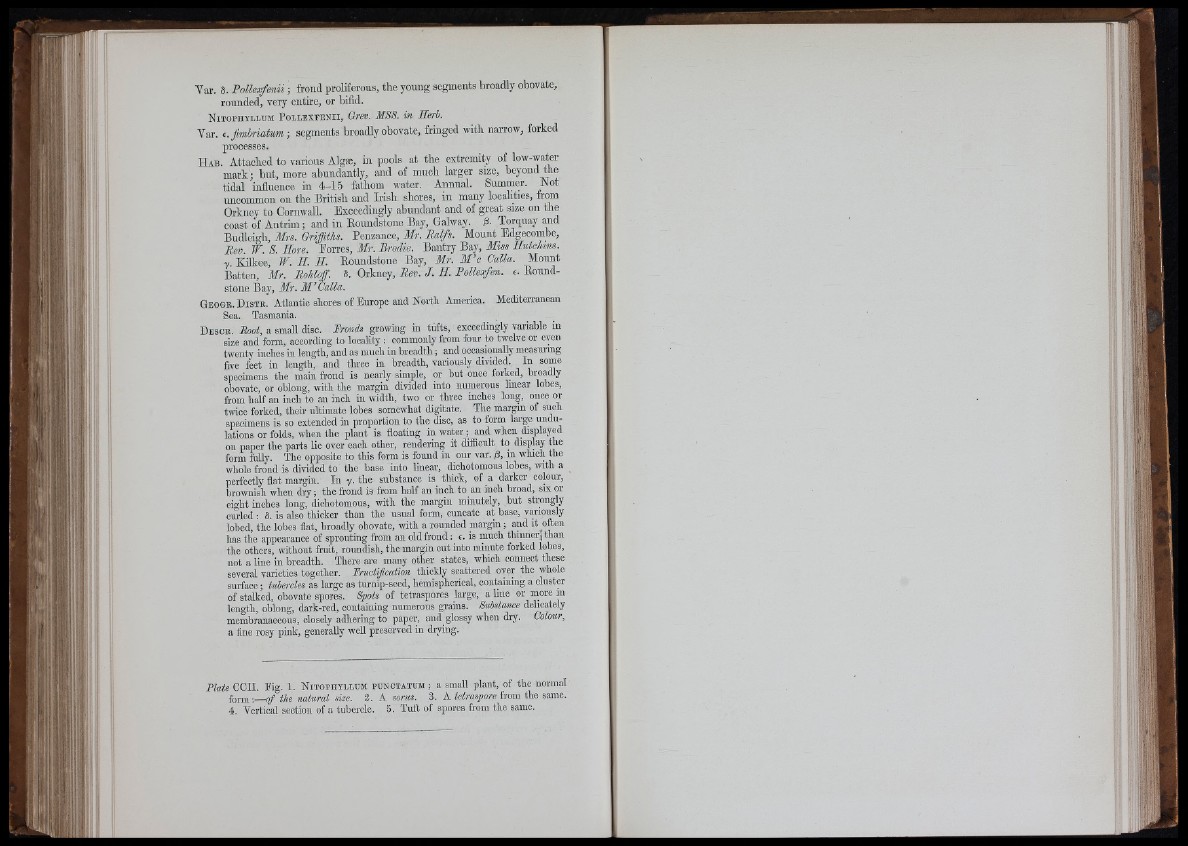
i i
Var. 8. P oUe x fen ii; frond proliferous, the young segments broadly obovate,
rounded, very entire, or bifid.
N it o ph y l lu m P o l l b x p b n i i , Orev. MSS. in Eerb.
Var. e .flm b ria tum ; segments broadly obovate, fringed with narrow, forked
processes.
H ab . Attached to various Algse, in pools at the extremity of low-water
mark; but, more abundantly, and of much larger size, beyond the
tidal influence in 4-15 fathom water. Annual. Summer. Not
uncommon on the British and Irish shores, in many localities, from
Orknev to Cornwall. Exceedingly abundant and of great size on the
coast of Antrim; and in Roundstone Bay, Galway. Torquay and
Budleigh, Mrs. Griffiths. Penzance, Mr. R a lfs . Mount Edgecombe,
Rev. IF. S. Ilore. Eorres, Mr. Brodie. Bantry Bay, Miss Ilu tchm s.
y Kilkee, W. I I. E . Roundstone Bay, Mr. M ’c Calla. Mount
Batten, Mr. R ohloff S. Orkney, Rev. J . I I. Pollexfen. e. Roundstone
Bay, M r. M ’Calla.
G e o g k . D is t b . Atlantic shores o f Europe and North America. Mediterranean
Sea. Tasmania.
D e sc k . Boot, a small disc. Fronds g iw in g in tufts, exceedingly variable in
size and form, accordmg to locality : commonly from four to twelve or even
twenty inches in length, and as much in breadth; and occasionally measui-mg
five feet in length, and three in breadth, variously divided. In some
specimens the main frond is nearly simple, or but once forked, broadly
obovate, or oblong, with the margin divided into numerous linear lobes,
from half an inch to an inch in width, two or three inches long, once or
twice forked, their ultimate lobes somewhat digitate. The margin oi such
specimens is so extended in proportion to the disc, as to form large undulations
or folds, when the plant is floating in water; and when displayed
on paper the parts lie over each other, rendering it difficult to display the
form fully. The opposite to this form is found in our var. /3, in which the
whole frond is divided to the base into linear, dichotomous lobes, with a
perfectly flat margin. In y. the snbstance is thick, of a darker colour,
irownisli when d iy ; the frond is from half an inch to an inch broad, six or
eight inches long, dichotomous, with the margin minutely, but strongly
cui-led : 8. is also thicker than the usual form, cuneate at base, variously
lobed, tbe lobes flat, broadly obovate, with a rounded margin; and it often
has the appearance of sprouting from an old frond: €. is much thinner j than
the others, without fruit, roundish, the margin cut into minute forked lobes,
not a line in breadth. There are many other states, which connect these
several varieties together, fructification thickly scattered over the whole
sm-face; tuhercles as large as turnip-seed, hemispherical, containing a cluster
of stalked, obovate spores. Spots of tetraspores large, a line or more in
length, oblong, dark-red, containing numerous grains. Substance delicately
membranaceous, closely adhering to paper, and glossy when dry. Colour,
a fine rosy pink, generally weU preserved in drying.
I
: 'i '
■ '■ '
J ri
ri i;
■ i
i r
f; Ai >
Plate CCII. Eig. 1. N it o ph y l l u m p u n c t a t u m ; a small plant, of the normal
form -.— of the natural size. 2. A sorus. 3. A tetraspore from the same.
4. Vertical section of a tubercle. 5. Tuft of spores from the same.
p i
f i
[foil